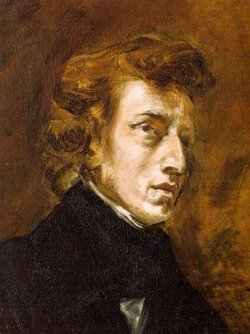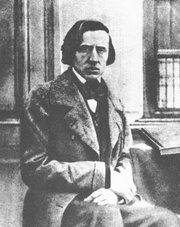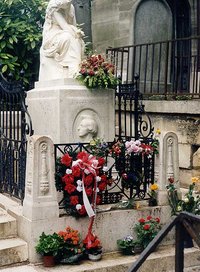Frederic Chopin - Biography
Frederic Chopin Biography
Frédéric-François Chopin (March 1, 1810 – October 17, 1849) is widely seen as the greatest of Polish composers and among the very greatest of composers for the piano, the instrument for which he wrote almost exclusively. He was born as Fryderyk Franciszek Chopin, adopting the French variant 'Frédéric-François' when he left Poland for Paris at age 20, never to return. His surname is also sometimes spelled Szopen in Polish texts. He was another one of the extremely rare child prodigies, including Wolfgang Amadeus Mozart and Felix Mendelssohn.

| Contents |
Biography
According to the artist himself and his family, Chopin was born on March 1, 1810. However, his baptismal certificate, written several weeks after his birth, lists his birthdate as February 22. Chopin was born in Żelazowa Wola in central Poland near Sochaczew, in the region of Mazovia, which was part of the Duchy of Warsaw. He was born to Mikołaj (Nicolas) Chopin, a Polonized Frenchman and to his Polish mother, Tekla Justyna Krzyżanowska.
Formative Years
The musical talent of young Chopin became apparent early on and can be compared with the childhood genius of Mozart. At the age of 7, he was already the author of two polonaises (in G minor and B-flat major), the first being published in the engraving workshop of Father Cybulski. The prodigy was featured in the Warsaw newspapers, and 'little Chopin' became the attraction at receptions given in the aristocratic salons of the capital. He also began giving public charity concerts. His first professional piano lessons, given to him by the violinist Wojciech Żywny (b. 1756 in Bohemia), lasted from 1816 to 1822, when the teacher was no longer able to give any more help to the pupil whose skills surpassed his own.
The further development of Chopin's talent was supervised by Wilhelm Würfel (b. 1791 in Bohemia). This renowned pianist and professor at the Warsaw Conservatory gave Chopin valuable (although irregular) lessons in playing organ (music), and possibly piano. From 1823 to 1826, Chopin attended the Warsaw Lyceum, where his father was a professor. In the autumn of 1826, Chopin began studying music theory, figured bass, and composition with the composer Józef Elsner (b. 1769 in Silesia) at the Warsaw Conservatory. In 1831 he left Poland for Vienna before settling in Paris where he spent much of his life.
Career in Paris
Chopin first visited Vienna in early 1829, where he gave a piano performace and received his first favorable reviews. The following year he returned to Warsaw and performed the premiere of his Piano Concerto in F Minor at the National Theater on March 17. By 1831 Chopin had left Poland for good and settled in Paris. He began work on his first scherzi and ballades as well as the first book of études. It is also at this time that he began his lifelong struggle with tuberculosis.
The early and mid-1830s in Paris were a productive time for the composer. He completed several of his most famous works and also performed regular concerts, to rave reviews. By 1838 Chopin had become a famous figure in Paris. Among his closest friends were opera composer Vincenzo Bellini (beside whom he is buried in the Père Lachaise), and painter Eugène Delacroix. He was also friends with composers Hector Berlioz, Franz Liszt and Robert Schumann, and although he was at times critical of their music, Chopin dedicated some of his own compositions to them.
Chopin and George Sand
In 1836 Chopin was secretly engaged to a seventeen-year-old Polish girl named Maria Wodzinska. The engagement was later called off. In that same year, at a party hosted by Countess Marie d'Agoult, Chopin met the novelist Amandine-Aurore-Lucile Dupin, better known by her pseudonym as George Sand.
Sand's correspondence suggests that Chopin was asexual; that is, that he had no inclination to have sexual relations with anyone, male or female. Even so, his relationship with Sand lasted for ten years until they parted after arguments over Sand's children.
A notable episode in their time together was a turbulent and miserable winter on Majorca (1838–1839) living in unheated peasant huts and in the then-abandoned (and equally cold) Valldemossa monastery. 1 (http://www.valldemossa.com/museoin.htm) Chopin would also later complain of having to go to great lengths to obtain a piano from Paris and of the difficulty of moving it uphill to the monastery. Chopin reflected much of the mood of this desperate time in the twenty-four préludes, Op. 28, the majority of which were written in Majorca. The weather had such a serious impact on Chopin's health and his chronic lung disease that he and George Sand were compelled to return to Paris to save his life. He survived but never recovered from this bout.
Death and Funeral
By the 1840s Chopin's health was rapidly deteriorating. He and Sand took several trips to remote locations, such as Nohant-Vic, to no avail. By 1849 most of his major works were completed and Chopin concentrated on mazurkas and nocturnes. His last work was a mazurka, in F minor.
Chopin died, officially, of tuberculosis in 1849, although there is some speculation that he may have had another disease such as cystic fibrosis or emphysema due in part to autopsy findings (reported only by his sister) seemingly inconsistent with the initial diagnosis. He had a terror of being buried alive, and asked to be 'cut open' to make sure he was dead.
He had requested that Mozart's Requiem be sung at his funeral, held at the Church of the Madeleine. The Requiem has major parts for female singers but the Madeleine had never permitted female singers in its choir. The funeral was delayed for almost 2 weeks while the matter raged, the church finally relenting and granting Chopin's final wish. Although Chopin is buried in the Père Lachaise cemetery in Paris, his heart is entombed in a pillar in the Church of the Holy Cross in Warsaw.
Music
Chopin's music for the piano combined a unique rhythmic sense (particularly his use of rubato, chromatic inflections, and the style of Johann Sebastian Bach), as well as a piano technique which was of his own creation. This mixture produces a particularly fragile sound in the melody and the harmony, which are nonetheless underpinned by solid and interesting harmonic techniques. He took the new salon genre of the nocturne, invented by Irish composer John Field, to a deeper level of sophistication, and endowed popular dance forms, such as the Polish mazurka and the Viennese waltz with a greater range of melody and expression. Chopin was the first to write Ballades (a genre he invented) and the Scherzi as individual pieces. Chopin also took the example of Bach's préludes and transformed the genre.
Several melodies of Chopin's have become well known; because of their unique melodic shape they are instantly memorable and easily recognized. Among these are the Revolutionary Étude (Op. 10, No. 12), the Minute Waltz (Op. 64, No. 1), and the third movement of his Funeral March sonata (Op. 35), which is used as an iconic representation of grief. Interestingly, the Revolutionary Etude was not written with the failed Polish uprising against Russia in mind, it merely appeared at that time. The Funeral March was written for funerals, but it was not inspired by any recent personal loss of Chopin's. Other melodies have even been used as the basis of popular songs, such as the slow section of the Fantaisie-Impromptu (Op. 66). These pieces often rely on an intense and personalized chromaticism, as well as a melodic curve that resembles the operas of Chopin's day - the operas of Rossini, Donizetti, and especially Bellini. Chopin used the piano to re-create the gracefulness of the singing voice, and talked and wrote constantly about singers.
Chopin's style and gifts became increasingly influential: Schumann was a huge admirer of Chopin's music — although the feeling was not mutual — and he took melodies from Chopin and even named a piece of his Carnaval Suite after Chopin; Franz Liszt, another great admirer of the composer, transcribed several Chopin songs for unaccompanied piano. Liszt later dedicated a movement of his 'Harmonies Poétiques et Religieuses' to Chopin, titling it 'Funérailles' and laconically dedicating it 'October 1849.' The mid-section recalls, powerfully, the famous octave trio section of Chopin's Opus 53 Polonaise.
Chopin had strong opinions of how his music should be performed and many common performances practices of Chopin today are at odds with his aesthetic. Arguably, some of the best records of Chopin include those by Koczalski, Friedman, Cortot, Rubinstein, Malcuzynski, Janis, Magaloff, Pollini and Zimerman.
Chopin performed his own works in concert halls but most often in his salon for friends. Only later in life, as his disease progressed, did Chopin give up public performance altogether.
Several of Chopin's piano works carry with them their own technique: his préludes (Op. 28) and études (Op. 10 and 25) rapidly became standard works. They also became influential, inspiring both Liszt's Transcendental Études and Schumann's Symphonic Études.
Chopin and Romanticism
Chopin regarded the Romantic movement with indifference, if not distaste, and rarely associated himself with it directly. Even so, today Chopin's music is considered to be the paragon of the Romantic style.
All of his works, without exception, involve the piano, whether solo or accompanied. They are predominantly for solo piano but include a small number of works for piano and secondary instruments, including a second piano, violin, cello, voice, and orchestra.
Works
Chopin's compositional output consists mainly of music for solo piano. His larger scale works such as the ballades, scherzos, the barcarolle, and sonatas have cemented a solid place within the repertoire, as well as shorter works like his impromptus, mazurkas, nocturnes, waltzes and polonaises.
Two important collections are the 24 Preludes Op. 28, based loosely on Bach's Well-Tempered Clavier, and the etudes, which are a staple of that genre for pianists.
Chopin's two piano concertos, Opp. 11 and 21, are masterpieces still often performed. In addition, he wrote several songs set to Polish texts, and several pieces including a piano trio and a sonata for cello and piano.
For a complete list of Chopin's works by opus number, see List of compositions by Frédéric Chopin.
Other
In commemoration of the genius of Frédéric Chopin, the International Chopin Piano Competition is held in Warsaw, Poland every five years.
Eponyms
The following have been named after the composer:
- Asteroid 3784 Chopin
- Warsaw Frederic Chopin Airport (also known as Frederic Chopin International Airport).
Media
- Listen to Chopin's Fantaisie-Impromptu in C-sharp minor, Op. 66 (20kB MIDI file) or download high quality synthesized version (3.5MB Vorbis file). Most of this piano solo features 4:3 polyrhythm.
See also
- Category:Chopin compositions
- Great Emigration
- Carl Mikuli, student, teaching assistant and editor of Chopin.
External links
- ChopinMusic (http://www.chopinmusic.net) - Chopin website with recordings, sheet music, photo galleries, a forum and more.
- Biographies (Project Gutenberg e-texts):
- Life of Chopin, by Franz Liszt (http://www.gutenberg.net/etext/4386)
- Frederick Chopin as a Man and Musician, by Frederick Niecks (http://www.gutenberg.net/etext/4973)
- Chopin: The Man and his Music, by James Huneker (http://www.gutenberg.net/etext/4939)
- Chopin's partitions (http://www.mutopiaproject.org/cgibin/make-table.cgi?Composer=ChopinFF&preview=1) from Mutopia Project
- Chopin's music collection on Classical Music Archives (http://www.classicalarchives.com/chopin.html)
- International Frederick Chopin Piano Competition (http://www.konkurs.chopin.pl/index_en.html)
Recordings
- Free recordings of Chopin's music (http://innig.net/music/betts-chopin/) performed by Donald Betts (3 ballades, 3 études, 2 nocturnes, 1 mazurka)
- Free recordings of Chopin's music (http://innig.net/music/inthehands/category/recordings/chopin/) performed by Paul Cantrell
- Piano Society.com — Chopin (http://www.pianosociety.com/index.php?id=9) — Various free recordings of Chopin's music in MP3 format.
- Classic Cat — Chopin (http://www.classiccat.net/chopin_f/index.htm) — An overview of free Chopin recordings on the internet by Classic Cat — the free classical music directory.
- The Chopin MIDI Archive (http://www.gressus.se/chopin/midi/chopin.html) — Chopin's works in MIDI format.




